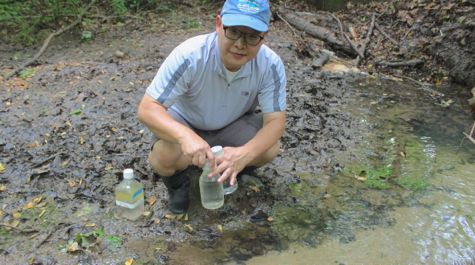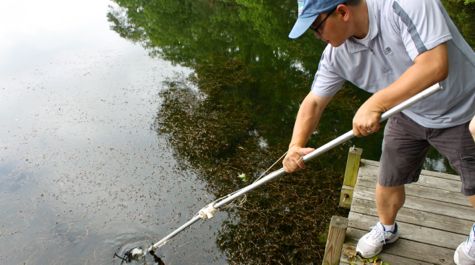New faculty member explores heart of nitrogen cycle
Studies of bacterial processes promise gains in water quality
To address one of the world’s big problems—nutrient pollution and its impacts on water quality—Dr. BK Song studies some of Earth’s smallest creatures, the bacteria and fungi that help power the global nitrogen cycle.
Song, one of several new faculty members at the Virginia Institute of Marine Science, is a microbial ecologist whose research focuses on understanding—and perhaps harnessing—a recently discovered process called “anammox.”
 Song says “Anammox is a process in which certain bacteria directly transform ammonium and nitrite—forms of inorganic nitrogen that fuel over-fertilization of coastal waters—into the inert nitrogen gas that makes up most of our atmosphere.”
Song says “Anammox is a process in which certain bacteria directly transform ammonium and nitrite—forms of inorganic nitrogen that fuel over-fertilization of coastal waters—into the inert nitrogen gas that makes up most of our atmosphere.”
Anammox, short for “anaerobic ammonium oxidation,” was unknown to science until 1995. It offers an alternative to the long-recognized processes of nitrification and denitrification, in which a different set of bacteria must first convert ammonium to nitrite before then converting the nitrite into nitrogen gas.
By better understanding these natural nitrogen-removal processes, Song and other researchers hope to provide the knowledge needed to further leverage their use in wastewater treatment plants and other settings.
Indeed, shortly after arriving at VIMS in 2013 from a professorship at the University of North Carolina Wilmington, Song began collaborating with Dr. Charles Bott at the Hampton Roads Sanitation District to examine HRSD’s use of a cutting-edge nitrogen-removal system at their wastewater treatment plant in York County.
“HRSD was the first operation in the U.S. to employ an anammox bioreactor in a real wastewater-treatment system,” says Song. “It’s been operating for two years and they are now also operating a second anammox process at their James River plant. I’ve been working with them to evaluate microbial activities of nitrogen removal in the effluent water from different treatment systems.”
Collaboration is also a hallmark of Song’s interactions at VIMS. Dr. Iris Anderson, who will co-teach Aquatic Microbial Ecology with Song this spring, says “BK brings an incredible diversity of interests to the Institute. He’s already collaborating with colleagues in Physical Sciences, EAAH [Environmental and Aquatic Animal Health], and Biological Sciences. He’s great in both the lab and the field. He goes out and looks at the ecology, then knows the molecular methods to use to determine which microbes are there and what they’re doing.”
“BK is also incredibly energetic,” says Anderson. “It seems he has a new idea every millisecond.”
Song developed his interest in nitrogen-removal processes and water quality while earning his Master’s and Ph.D. degrees at Rutgers University. “My graduate training started with denitrifying bacteria,” says Song. “I was interested in how denitrifiers degrade organic contaminants while respiring nitrate and nitrite under anaerobic conditions.”
Song’s interest in anammox began to develop during collaborations with Dr. Craig Tobias at UNCW. “The Cape Fear estuary near Wilmington is an anammox sanctuary with diverse anammox bacteria,” says Song. “That’s where my career really started to focus on anammox diversity and process.”
Greenhouse gases
One reason Song finds anammox so intriguing is that it—unlike denitrification—doesn’t involve production of nitrous oxide (N2O), a greenhouse gas that is 300 times more potent than carbon dioxide.
“Production of N2O is one of the intermediates of denitrification, but anammox bypasses that process,” says Song. “So I began thinking that anammox could be a good solution not only to reduce nitrogen but also to reduce levels of greenhouse-gas emissions from aquatic ecosystems and agricultural soils.”
Farmed soils, fed with nitrogen-rich fertilizers, are known to emit high levels of nitrous oxide, through the action of both soil bacteria and fungi. Song now has funding from the U.S. Department of Agriculture to study the interplay between these two groups of organisms, particularly in light of the application of manure-based fertilizers.
“Soil fungi can produce more of the greenhouse gas N2O than bacteria,” says Song. “When livestock farmers raise pigs and other animals in concentrated facilities, they feed them antibiotics to keep them healthy. They then store the manure and use it fertilize their fields. This practice may reduce bacterial activity in the soil, but doesn’t affect soil fungi. My USDA study focuses on how the application of antibiotic-contaminated animal manure to soil affects bacteria, fungi, and N2O emissions.”
Song also has a new grant from the National Science Foundation to explore nitrogen cycling in local oyster reefs. “Oysters can improve water quality by filtering nutrients and particles from the water column and depositing them in the sediment,” says Song. “But a recent study we did shows they can also produce nitrous oxide through incomplete denitrification. Our NSF grant will allow us to study the environmental factors influencing N2O production and the nitrogen-removal capacities of oyster microbiomes.”
 Early career
Early career
Song’s work at the intersection of agriculture and water quality is a natural outgrowth of his early academic training and childhood curiosity. A native of South Korea, he earned his Bachelor’s degree in Agriculture Biology from Dongguk University in his hometown of Seoul.
“I was interested in biochemistry and animal physiology,” says Song. “I began thinking about environmental problems in Korea—from all the industrialization—leading to a lot of pollution and contamination of the ecosystem. That grew into the interest in biodegradation and bioremediation that led me to Rutgers.”
Song says his scientific curiosity started when he was in elementary school. “When I read about photosynthesis I wondered, ‘How come humans can’t do that?’” After collecting leaves and scraping them to remove the chlorophyll, he tried to feed the experimental mixture to his dog. The experiment ended when the dog refused the offering, but it did have a lasting impact.
“When I taught a Cell Biology course at UNCW,” says Song, “I used my photosynthesis experiment as an example of my interest in science as a kid.”




